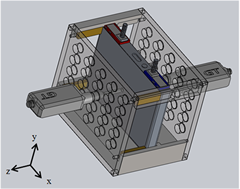Advanced Structures & Materials
Annual PlanAdvanced Models for Fatigue Life Predictions of Hybrid Electric Vehicle Batteries
Project Team
Government
Matthew Castanier, U.S. Army GVSC
Industry
Ramesh Rebba, Thomas Wang, General Motors
Sungkwon Hong, Ford Motor Co.
Student
Jau-Ching Lu, Ki-Yong Oh (Post-Doc), University of Michigan
Project Summary
Project started in 2013 and was completed by 2015.

There GVSC 30 year strategy identifies an ever increasing electrical power demand on military vehicles and requires vehicles possess 45kW of electrical power while stationary. This can be addressed by hybrid powertrains which use advanced battery systems.
A typical hybrid electric vehicle (HEV) battery has 100–300 prismatic rechargeable Lithium-ion pouch cells which are stacked into several packs. These batteries are subject to environmental temperature conditions and undergo thousands of charge-discharge cycles where they change temperature and thickness. Thermal fields created by the electro-chemical processes and the cooling system lead to varying face pressures on the cells. These variations impact both their electrical performance and their vibratory dynamics. That affects fatigue life. Moreover, the stress-strain dependence is nonlinear both in the cells and in the foam used between cells for padding. Also, uncertainties in cell and foam mechanical/thermal properties are ubiquitous. Thus, accurate yet computationally fast models are needed to predict vibratory responses for fatigue life predictions to enable statistically optimal designs of stacking and cooling solutions.
The main goal of this research is to create a novel framework to model & analyze the dynamics of battery packs for fatigue life predictions. The three key objectives are to:
- Develop novel methods for creating parametric reduced order models (ROMs) which capture cell-to-cell variations in structural properties, temperature, cooling properties, stresses, and stacking solutions;
- Develop methods for creating innovative nonlinear PROMs (parametric ROMs) which can capture the effects of nonlinear material behavior in various components (e.g. in the pouch cells);
- Develop fatigue life prediction tools based on linear and nonlinear PROMs and methods to evaluate the effects of impact loading (e.g. blast events) on the structural health of battery systems.
The immediate challenge is for battery systems, but there are other periodic structures in vehicle systems where such models are needed, such as layered structures (e.g., armor and understructure). This project provides GVSC a new/effective analysis technology and enhances design capabilities for such structures.
Deliverables:
Novel methodology for constructing unique PROMs able to capture prestress variations, cell-to-cell structural variations, stacking solutions, and the effect of nonlinear materials in cells. This method is unique in that it combines for the first time the fundamental scientific background of CMM and novel insights in the dynamics of layered/periodic structures. For linear materials, PROMs are approximately 13,000 to 15,000 times faster than full order models with errors less than 2% in predicting vibration amplitudes. For nonlinear materials, PROMs are approximately 26,000 times faster than state-of-the-art time-marching methods with errors less than 5% in predicting vibration amplitudes. The work involves not only structural modeling, but also thermal modeling. The multi-physics nature of these processes makes the new methods particularly unique. As technical transfer, the new PROMs make an impact because they allow rapid evaluation of the stresses in a battery pack.
Publications:
- Sung-Kwon Hong, Bogdan I. Epureanu, Matthew P. Castanier, “Parametric reduced-order models of battery pack vibration including structural variation and pre-stress effects”, Journal of Power Sources, Volume 261, Pages 101-111, 2014. doi: 10.1016/j.jpowsour.2014.03.008
- J. Lu, K. D’Souza, B. I. Epureanu, and M. P. Castanier, “Parametric Reduced-Order Models of Battery Pack Vibration Including Structural Variation, Pre-Stress, and Temperature Effects”, 17th U. S. National Congress on Theoretical and Applied Mechanics, East Lansing, Michigan, June 2014.
- S. K. Hong, B. I. Epureanu, and M. P. Castanier, “Parametric Reduced-Order Models of Battery Pack Vibration Including Structural Variation and Pre-stress Effects”, Proceedings of the SAE 2013 Noise and Vibration Conference (NVC), SAE Paper 2013-05-13, Grand Rapids, Michigan, May 2013. doi: 10.4271/2013-01-2006

